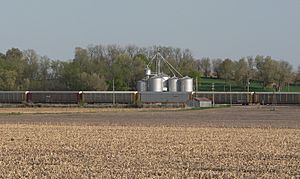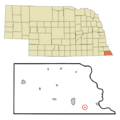Preston, Nebraska facts for kids
Quick facts for kids
Preston, Nebraska
|
|
|---|---|
|
Village
|
|

Grain elevator and train in Preston
|
|

Location of Preston, Nebraska
|
|
| Country | United States |
| State | Nebraska |
| County | Richardson |
| Area | |
| • Total | 0.06 sq mi (0.15 km2) |
| • Land | 0.06 sq mi (0.15 km2) |
| • Water | 0.00 sq mi (0.00 km2) |
| Elevation | 938 ft (286 m) |
| Population
(2020)
|
|
| • Total | 19 |
| • Estimate
(2021)
|
19 |
| • Density | 333.33/sq mi (128.78/km2) |
| Time zone | UTC-6 (Central (CST)) |
| • Summer (DST) | UTC-5 (CDT) |
| ZIP code |
68355
|
| Area code(s) | 402 |
| FIPS code | 31-40325 |
| GNIS feature ID | 2399023 |
Preston is a small village located in Richardson County, in the southeastern part of Nebraska, United States. It is found within the area known as the Sac and Fox Reservation. In 2020, only 19 people lived in Preston.
Contents
Preston's Past: A Look at Its History
The area where Preston now stands had a post office called Sac Post Office, which opened in 1874. It was named after the Sac and Fox Native American tribes who lived there. Some people from mixed marriages, often with early French trappers, were given land in a special area called the Half-Breed Tract. Some of their families still live there today.
How Preston Got Its Name
Preston was officially planned out in 1878. This happened when the Atchison & Nebraska Railroad built tracks to that spot. In February 1880, Philip R. Shelly, who is known as the town's founder, built a store. He wanted to open a post office and suggested the name "Blufton."
However, the postal service said no because there was already another "Blufton" in Nebraska. James Eatough, who worked for Shelly, had moved from Preston, England. He suggested the name "Preston" instead. On June 23, 1881, both the post office and the railroad agreed to the name "Preston."
Early Days of the Village
In 1881, Shelly planned the town on about 40 acres of land. It stretched along the railroad tracks where trains could stop. An elevator and a train station were built next to the tracks for trading goods and for travelers. A. D. McAlpine, a telegraph operator from Canada, was the first person to work as the train station agent.
Philip R. Shelly became the first postmaster. He owned one of the general stores and a drugstore. He also ran a saloon and owned a stable for horses. Shelly was a busy man! He bought and sold cattle and hogs, sending them to big markets in cities like St. Joseph, Kansas City, and Chicago. Train yards were very busy on Monday and Tuesday nights as men loaded many train cars with livestock.
Preston had many businesses in its early days. There was a bank, three general stores, and two barber shops. It also had two drugstores, two stables for horses, and two blacksmiths. There were even two hotels for visitors. One of the harness shops, which made horse equipment, hired six girls to make special nets to keep flies away from horses.
School Life in Preston
Preston's first school was just one room. It served the community until 1889, when a bigger schoolhouse was built. The school grounds had a four-foot fence to keep animals out. In the 1920s, several other school areas joined with Preston. They even had a high school that taught students for three years.
Peak Population and Community Life
Preston was at its busiest in 1890, with 150 people living there. The people of Preston had many different jobs and hobbies. Everyone helped the town grow by supporting local businesses. It was an important place for farmers to sell their crops and buy things they needed.
The two two-story hotels gave traveling salesmen a place to stay overnight. These salesmen would sell their products to the local shop owners. The person who ran the Central Hotel couldn't read or write. So, he would make an "X" whenever he needed to approve something in writing.
Entertainment and Gatherings
People in Preston had many ways to have fun. There was a dance floor above the bank, which also served as a community opera house. They held different events there, like short plays, readings, and debates on important topics. Sometimes, "medicine shows" would also visit.
The local school was used for public events, such as political debates. Preston's post office was on Iowa Street, close to the train station. The German Evangelical Church was further south. A group called the Bethel Dunkard Society held church services in German at the schoolhouse.
Challenges and Decline
On May 17, 1896, a very strong cyclone almost destroyed Preston. It also caused a lot of damage in other parts of southeast Richardson County and northeast Kansas, and some people died. Almost every building in Preston was either blown away or needed major repairs.
Fires also caused problems. In 1891, the Shelly & Rieger general store burned down. In 1903, a fire at the harness shop spread and burned most of the block. This included four or five businesses and the Lindell Hotel.
It cost only 17 cents to take the train from Preston to Falls City. This cheap and easy way to travel made Preston decline even more. People could easily go to the bigger city of Falls City to get what they needed.
After the cyclone and the fires, the town slowly started to shrink. The Central Hotel and Farmers National Bank were taken apart and moved to Falls City. When cars became popular, people drove to Falls City for their shopping. Local stores in Preston couldn't compete, so they closed one by one.
In 1928, Preston's elementary school was still open, but that year was the last time the community had a high school class. Shelly's General Store, owned by Ryan (or Bryon) Shelly, was still open as late as 1933. In 1928, it was robbed twice during a time when many small stores in the county were being burglarized.
By 1969, only the post office, the elementary school, and a voting hall were left in Preston. The post office became a rural branch in 1974. The elementary school joined with Falls City schools. The train station closed in 1953, but coal trains still rumble along the north side of town regularly.
Preston's Geography
According to the United States Census Bureau, the village of Preston covers a total area of about 0.15 square kilometers (0.06 square miles). All of this area is land, with no water.
Preston's Population Over Time
| Historical population | |||
|---|---|---|---|
| Census | Pop. | %± | |
| 1900 | 149 | — | |
| 1910 | 122 | −18.1% | |
| 1920 | 113 | −7.4% | |
| 1930 | 77 | −31.9% | |
| 1940 | 120 | 55.8% | |
| 1950 | 81 | −32.5% | |
| 1960 | 66 | −18.5% | |
| 1970 | 64 | −3.0% | |
| 1980 | 45 | −29.7% | |
| 1990 | 40 | −11.1% | |
| 2000 | 50 | 25.0% | |
| 2010 | 28 | −44.0% | |
| 2020 | 19 | −32.1% | |
| 2021 (est.) | 19 | −32.1% | |
| U.S. Decennial Census | |||
Population in 2010
In 2010, the census showed that 28 people lived in Preston. These people lived in 13 households, and 9 of those were families. The population density was about 467 people per square mile (180 people per square kilometer). This means that for every square mile of land, there were about 467 people.
There were 14 housing units, meaning places where people could live. About 82.1% of the people were White, and 14.3% were Native American. About 3.6% of the population identified as being from two or more races. A small percentage, 3.6%, were Hispanic or Latino.
Out of the 13 households, 15.4% had children under 18 living with them. Almost half (46.2%) were married couples living together. About 15.4% had a female head of the household with no husband present. And 7.7% had a male head of the household with no wife present.
The average age of people in the village was 50.5 years old. About 10.7% of residents were under 18. Many people, 42.9%, were 65 years old or older. The village had more males (60.7%) than females (39.3%).
Education
Students in Preston attend schools that are part of the Falls City Public Schools district.
Images for kids
See also
 In Spanish: Preston (Nebraska) para niños
In Spanish: Preston (Nebraska) para niños



